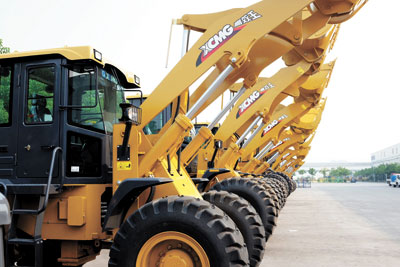
TWO years after China unveiled a sweeping plan to rebuild Silk Road trade links with Europe and Asia, machinery maker XCMG Group has opened a factory in Uzbekistan, sent 300 staff abroad and set ambitious goals to grow overseas.
XCMG’s foreign venture piggybacks on China’s bold scheme to extend its global influence through financing infrastructure projects in 65 nations that are home to two-thirds of humanity, and at the same time win new markets for companies weighed down by profit-crushing overcapacity at home.
“This is China’s grand strategy,” said Hanson Liu, assistant president at Xuzhou Construction Machinery Group (XCMG), which aims to grow overseas income from 15 percent of total revenue in 2014 to more than 30 percent in the next five years.
“It’s like how a person in a village has gotten rich and wants to fix roads, build power points, street lamps for the neighborhood.”
Stretching from Hungary to Indonesia, the Chinese Government estimates its “One Belt, One Road” initiative will add US$2.5 trillion to China’s trade in the next decade, more than the value of its exports in 2013 — when it was the world’s top exporter.
While it is too early to assess whether that lofty goal will be realized, the drive offshore is already proving a boon for firms like XCMG, whose listed unit, XCMG Construction Machinery, has posted three years of declining sales.
“Our company, from top to bottom, is focused on this,” said Liu in an interview at XCMG’s campus in Xuzhou, an industrial city in coastal Jiangsu Province where the government-owned firm, one of China’s biggest heavy machinery makers, is the largest employer.
After years of breakneck growth, the extent of China’s overcapacity problem is becoming clear as waning domestic demand and efforts to re-tool the economy slows growth to a pace dubbed by President Xi Jinping as the “new normal.”
That has exposed supply gluts that are especially glaring in the steel, coal and cement sectors, where factories have the capacity to produce up to 30 percent more than current demand, official data showed.
“One Belt, One Road” — the name comes from abbreviating the two planks of the scheme, the “Silk Road Economic Belt” and the “21st Century Maritime Silk Road” — aims to carve out new markets for goods that China makes too much of.
There is evidence, from companies and data, that some effect is already being felt.
Auditing firm PWC estimates that more than US$250 billion worth of projects, from railways to power plants, have been contracted since “One Belt, One Road” was announced in 2013.
Buoyed with a US$50 billion credit line from the Bank of China for such projects, China’s largest cement maker, Anhui Conch, is building at least six cement plants in Indonesia, Vietnam and Laos, according to its website.
Steel firms have also said that they are looking to ramp up foreign acquisitions to move capacity to regions such as Southeast Asia and Eastern Europe.
In Shijiazhuang, the capital city of Hebei Province, which surrounds Beijing and is China’s biggest steel producer, steel exports spiked almost 50 percent to 36.5 billion yuan in the first seven months this year.
The number of Chinese workers employed abroad by Chinese firms shot up by 18 percent to 1 million last year, having crept up by just 4 percent in 2013, commerce ministry data showed.
But while firms like XCMG, which were already active overseas, are finding “One Belt, One Road” hits a sweet spot, others are struggling to gain a foothold.
Eight steel mills in Hebei who spoke to Reuters said the scheme was not increasing demand enough to solve their biggest problem, low prices caused by excess supply.
The infrastructure drive also risks running counter to another of the Central Government’s policy goals, reforming China’s State-run giants — the very firms expected to win the bulk of “One Belt, One Road” deals struck between governments, according to a manager at a steel mill in Hebei.(SD-Agencies)
|

